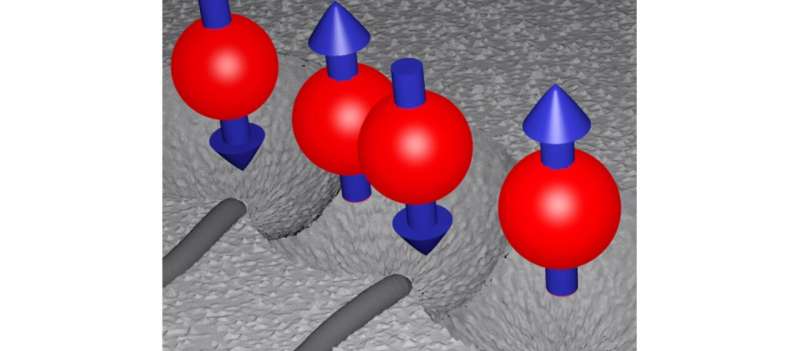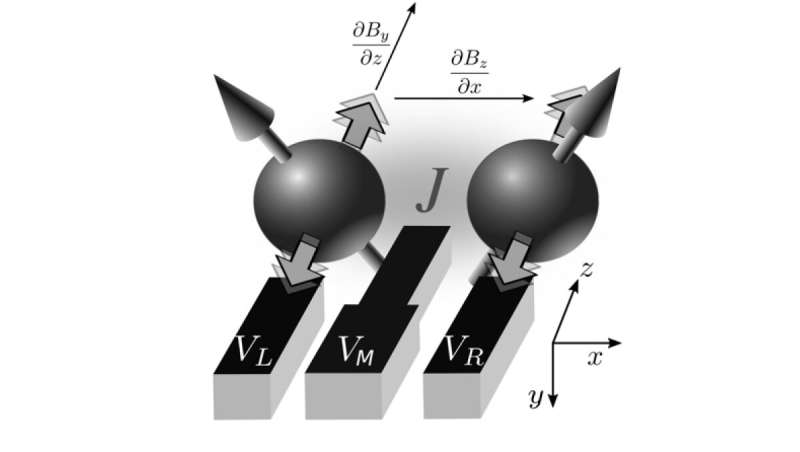AG Burkard | Schematic image of the new spin qubits consisting of four electrons (red) with their spins (blue) in the surrounding semi-conductor structure (grey)
The race for the quantum computer will most likely be decided at the quantum bit (qubit) – the smallest information unit of the quantum computer. The coupling of several qubits into a computing system is currently one of the greatest challenges in the development of quantum computers. A key question is which physical system and which material are best suited for qubits. Development of qubits based on superconductors has advanced farthest—but there are increasing signs that silicon semiconductor technology may be a promising alternative with decisive advantages in chip production.
The classical bit is the smallest data storage unit of our current computers. It can take on exactly two values: One and zero—or in other words: A current either flows ("one") or does not flow ("zero"). The quantum bit, on the other hand, is not limited to these two states: It can assume an intermediate state of one and zero at the same time, known as "superposition." Only at the moment of measurement is this intermediate state brought to a fixed value. In other words: Whereas normal bits have a defined value at any given time, qubits take on a defined value only at the respective moment of measurement. This property is the basis for the massive computing power that quantum computers can harness for some problems.
This makes storage of such quantum information much more complicated—a simple "current on/current off" is not enough. Instead, the fastest and smallest processes in space and time serve as the basis: Quantum states of electrons or photons can be used to implement a qubit. In the case of silicon quantum bits, the intrinsic angular momentum of a single electron—the electron spin—is used for information storage. Here, the rotational direction of the electron in combination with its quantum state encodes the quantum information. This is, understandably, highly fragile, as even the most subtle disturbances at the atomic level can affect the angular momentum of an electron and destroy the quantum information.
Today's challenge: Coupling quantum bits
An even more difficult task is interconnecting quantum bits because a single quantum bit is not sufficient to carry out an arithmetic operation. Just like standard computers, quantum computers require multiple (quantum)bits to be linked together to form a computing system: Consequently, the individual qubits must be able to interact with each other. If the qubits to be coupled are far apart on the chip, one qubit must first be brought into the vicinity of the other with a kind of "quantum bus" to enable a computing operation.
Quantum gate comprised of two silicon electrons. The angular momentum of both electrons is controlled by two nano-electrodes (VL and VR). A third nano-electrode (VM) coordinates the interaction of both electrons. Credit: University of Konstanz
In the case of the spin-based qubit, this means that the angular momentum of an electron must be transported or transferred to another electron precisely and with a minimum of disturbance—and not just once, but potentially thousands or even millions of times. A challenge for science—interconnecting the qubits is currently probably the biggest obstacle in the development of quantum computers. "It makes a difference whether you set up a single quantum bit or whether you team up tens, hundreds or thousands of them. Interactions can occur between the qubits that are difficult to control," describes Professor Guido Burkard, professor of theoretical condensed matter physics and quantum information at the University of Konstanz.
Currently, the most advanced quantum computer prototypes achieve coupling of some 20 to 50 qubits. "This is a major success already. However, there is still a long way to go before we come to an actual application. Thousands or millions of qubits are needed to perform meaningful arithmetic operations," says Guido Burkard.
The potential of silicon
The most advanced quantum computer systems to date are based on superconductors. Superconductor-based systems are extremely powerful, but they have to contend with limitations: They do not operate at room temperature, but at temperatures just above absolute zero (at around -273 C). In addition, superconductors are relatively energy-intensive and comparatively large from the point of view of technical miniaturization, so that only a small number of superconductor-based qubits fit on a chip.
Alongside the further development of superconductor qubits, research is also going into alternative systems. Silicon is one of the most promising materials: "We believe that silicon-based semiconductor qubits offer great prospects," explains Guido Burkard. Silicon-based quantum bits have the advantage that, being only a few nanometres in size, they are decidedly smaller than superconductor systems. Consequently, many more of them can be put into a computer chip—potentially millions. "Moreover, industry already has decades of experience with silicon semiconductor technology. The development and production of silicon-based qubits benefits enormously from this—which is no small advantage," Guido Burkard explains.
As early as 2017, Guido Burkard's research team, in collaboration with Princeton University and the University of Maryland, succeeded in creating a stable "quantum gate" for silicon qubits—i.e. a switching system for initially two-qubit systems that was capable of performing all the basic operations of the quantum computer. A milestone on which the physicists are now building: "Our task now is to scale up and interconnect as large a number of silicon qubits as possible with a minimum of crosstalk," Burkard says. To achieve this goal, he has now joined forces with leading research teams in the field of qubit development within the framework of three large research networks at the levels of Europe, Germany and Baden-Württemberg.
Provided by University of Konstanz
























